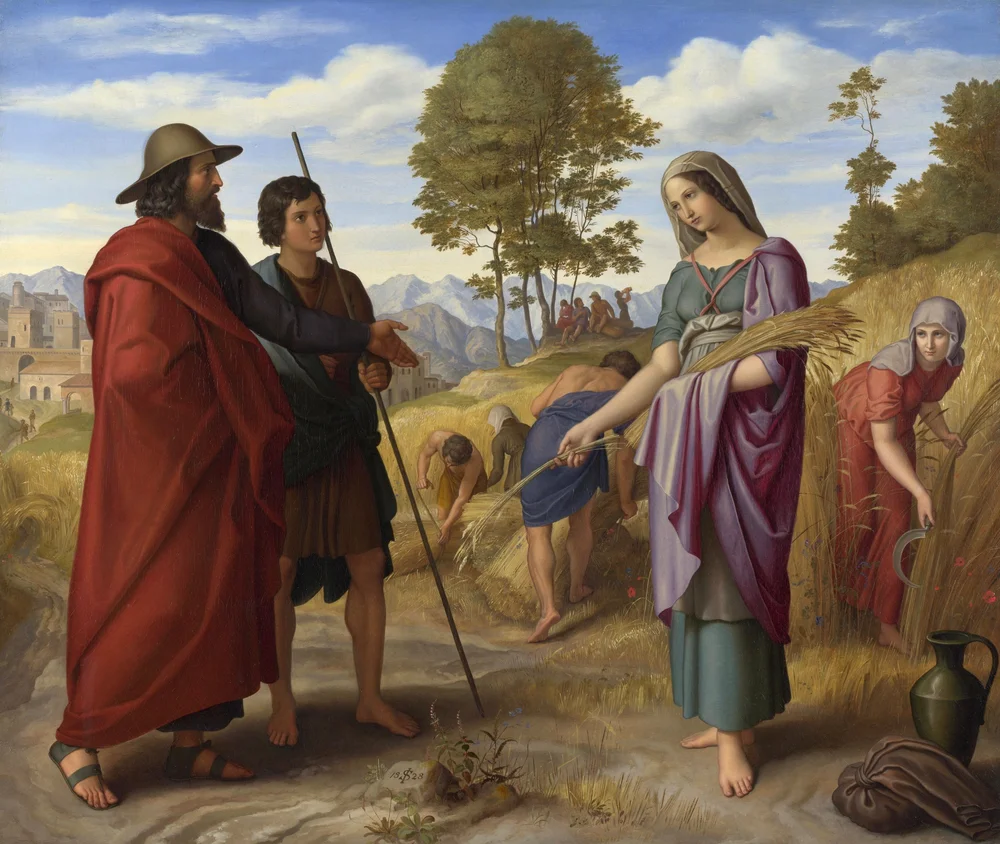
Ruth in Boaz’s Field by Julius Schnorr von Carolsfeld; National Gallery, United Kingdom. Image from Wikimedia Commons.
Many theologians have acknowledged the typological role that Boaz played in redemptive history. He descended from the tribe of Judah, came out of Bethlehem to bless his people, was the great grandfather of David, the one to whom the promise of Messiah was given, and was therefore in the genealogical line of the Christ.
Boaz owned a field into which he sent his laborers. He received a Gentile, Ruth, when she came to the fields to glean. He ultimately became the kinsman redeemer of both Jew and Gentile, buying the lost inheritance of Naomi and Ruth (Ruth 4:4 and 4:8), thus gaining the right to make Ruth his bride.
In all these ways Boaz is a type of Christ. Christ is the Lion of the tribe of Judah, who comes out of Bethlehem to bless his people. He is the Son of David, the redeemer of God’s elect. He sends his laborers into his fields to work. He treats his own people well. He receives and welcomes Gentiles. He pays our debt, and therefore gains the right to make us his bride. Yet, there are two significant elements of the work of Boaz, the typical redeemer, that must be recognized.
1. Boaz had to honor and keep the demands of the Mosaic law.
When Ruth comes and lays at Boaz’s feet, he does not immediately receive her. He tells her that there is a relative closer than himself who has a right to redeem her. Boaz is acting in accord with the law of God as revealed in Numbers 27:8-11 and Leviticus 25:25:
If a man dies and has no son, then you shall cause his inheritance to pass to his daughter. If he has no daughter, then you shall give his inheritance to his brothers. If he has no brothers, then you shall give his inheritance to his father’s brothers. And if his father has no brothers, then you shall give his inheritance to the relative closest to him in his family, and he shall possess it. And it shall be to the children of Israel a statute of judgment, just as the LORD commanded Moses. (Num. 27:8-11)
If one of your brethren becomes poor, and has sold some of his possession, and if his redeeming relative comes to redeem it, then he may redeem what his brother sold. (Lev. 25:25)
In this way, Boaz was acting in accord with the law of God. He was honoring the demands of the law and obeying the Lord in his dealings with Ruth. He does not—and in a very real sense cannot—redeem Ruth and Naomi until he obeyed the legal demands of the Lord.
2. Boaz also had to pay the price to redeem Ruth.
In order for him to be Ruth’s redeemer, Boaz must first obey the demands of the law, and then pay the price to redeem her. It is a beautiful picture of the dual nature of the work of Christ. Jesus first fulfills the righteous requirements of the law of God, and then he pays the price in his death on the cross.
Our redemption was accomplished in the active and passive obedience of the Savior. He was, in the words of the apostle Paul, “obedient to the point of death, even the death of the cross” (Phil. 2:8).
Together, these two aspects of the obedience of Christ form the grounds of our justification. We are forgiven by his death, and we are counted righteous by his perfect life. Jesus’ sacrifice is accepted because of his sinless conformity to the law. By his obedience and death, Christ has merited righteousness for his people. He is our redeemer according to the prescriptions of his Father, as typified in the laws of the kinsman redeemer.
Related Articles:
-
One Word That Explains Why Your Salvation in Christ Is Secure
-
Got Peace Right Now? 7 Things You Need to Know About Your Justification in Christ
-
Jesus Is the True and Faithful Gardener Who Cares for Your Soul
-
6 Reasons Why Adam and Eve’s Eating of the Forbidden Fruit Was a Terrible Transgression against God
Recommended:
Death in Adam, Life in Christ: The Doctrine of Imputation by J. V. Fesko
This article is adapted from “Boaz: The Law-Keeping/Debt-Paying Redeemer” from feedingonchrist.org.
from Blog - Beautiful Christian Life https://ift.tt/r2xq5zC
via IFTTT

No comments:
Post a Comment